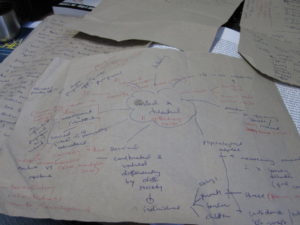One of the juniors asked me if giving students a concept map assignment is appropriate to measure cognitive skills (the code C6 – creating level). I asked him back what makes him think otherwise because to produce a concept map is not easy. It is not simply cut-copy-paste thingy (unless one copies other’s concept map). To produce one as your own, you need to have a good understanding about a concept and how it relates to other sub-concepts. It is not easy to produce a good and meaningful concept-map. I guess, this junior rarely uses concept maps to be articulated and reflective. Apparently from his question, it does resonate with that parts that he seems to be lacking of.
While doing my PhD, I did many concept maps like this. But, I find it difficult to draw a concept map in a white A4 paper. So, I changed the medium. I wrote on brown paper napkins that I could find inside any toilet in my school and it is FOC. It did help me to stay focused on what I want to write and organise my thoughts. In fact, a concept map is one of the ways that self-regulated learners will use to be reflective in a pictorial form. There are research about this.
So, when I crafted the assignments that I want to assign to my students taking SPPP1012 Educational Psychology, I want to them to be reflective. Being reflective demands a person to have a certain routine and habit. In this case, to produce a concept map for every topic learned also means helping students to develop a routine which I hope will turn into a habit. 2 in 1 thingy. Students will learn how to produce concept maps and hopefully they could teach it to others. Secondly, students might also develop good habits to summarise their thoughts in different forms i.e. pictorial format.
What a heck! As a teacher later on, the students will have to teach their secondary students how to illustrate points using I-think note (I-think note is a form of concept map). How can they teach the students if they never had any experience to draw concept map before? As an instructor, I ask the students to submit the concept map on regular basis because I would have a look at their concept maps and give my feedback so that their concept maps would be useful and more meaningful. This is an example that I “show” real example to my students so that when they become teachers, they would make it as part of their habits to give feedback to students.
For more information about I-think, check it out on KPM website.

